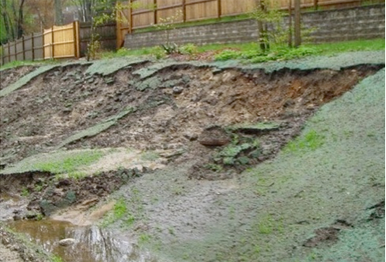The secret spoiler of habitat restoration projects on slopes has always been hydrostatic pressure. This mysterious term is brought to light in this monograph.
READ: UNDERSTANDING HYDROSTATIC PRESSURE IN SLOPE STABILIZATION

The secret spoiler of habitat restoration projects on slopes has always been hydrostatic pressure. This mysterious term is brought to light in this monograph.
READ: UNDERSTANDING HYDROSTATIC PRESSURE IN SLOPE STABILIZATION

Download "Understanding The Coastal Process"
The Earth's three-dimensional landforms traditionally represent symbols of security. Things are very different on Cape Cod which is a temporary creation of glacial sand. Our three-dimensional landform is constantly being refined by another dimension: the fourth dimension of time. The four dimensional model does not symbolize security the grains of sand we live on were once mountaintops, thousands of feet high, hundreds of thousands of years ago. Weathering (exposure to the elements) de-constructs mountains chemically and physically, leaving behind indestructible granite particles. These sandy, mountain memories were carried down thaw swollen brooks and stream into rivers. The river's journey is over when it finds the sea. The burden of sand can be released. Heavier sand drops out near the coast, while finer, lighter particles are carried out to sea. Moon generated tidal currents, run parallel to the coast, transporting sand up and down the coastline. Wind generated wave patterns deliver the sand shoreward onto beaches. Seasonal winds continue moving this sand from beaches into sand dunes. The dunes closest to the beach have the heaviest sand particle mix. The dunes furthest from the beach have the lightest particle mix.

June 12, 1984 Cape Cod - image source: NASA Earth Observatory

August 17, 2008 image source: NASA Earth Observatory
During the last hundred thousand years or so, New England's coastal beaches had a visit from another mountain. This time it was a mountain of ice. Nearly a mile thick, grinding inexorably and crudely down from the north. Heavy enough to depress our continental plate, this thousand mile wide bulldozer stole boulders, cobbles, stones and beach sand on its way south. Where cape cod sits today, warmer weather patterns melted ice as fast as it advanced. This glacial aftermath was first exposed to daylight around twelve thousand years ago. Climate change and subsequent advances and retreats of the glacier eventually left a four hundred foo high pile of sandy rubble where Cape Cod is today. At that time Cape Cod was several hundred feet above the dry coastal plate, reaching eastwards a mile or two further than it sits today. Compressed layers of bright sand and colored dark clay marked the glacial seasons of high and low melt-water flow. Small greenish stones found on our beaches are olivine, from the laurentian field in Canada. Six thousand years ago, give or take, rising sea level from the melted glacier reached Cape Cod, to begin taking back what it had left behind.


Special equipment, planned access from the back dune area and matched particle size and mix are considerations in restoration of a coastal resource.
Beginning to put a damaged coastal dune back together. Utilizing the same wind that nearly destroyed this dune, these open ended, semi-concentric fences allow wind and sand to enter the blow out area. This fencing slowed down wind. Sand dropped out of the wind to begin filling the hole until we had our restoration plan in place.
Safe Harbor 2009 For more information on this coastal dune restoration, check out our Images page or Gordon Peabody, 508-237-3724 or click here gordonsafeharbor@yahoo.com